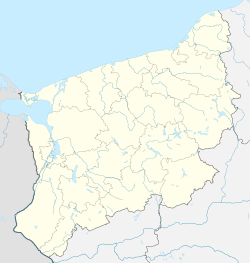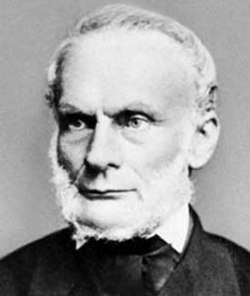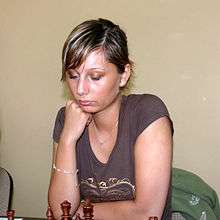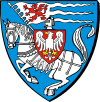Koszalin
| Koszalin | |||
|---|---|---|---|
 Koszalin Market Square | |||
| |||
 Koszalin  Koszalin | |||
| Coordinates: 54°12′N 16°11′E / 54.200°N 16.183°ECoordinates: 54°12′N 16°11′E / 54.200°N 16.183°E | |||
| Country | Poland | ||
| Voivodeship | West Pomeranian | ||
| County | city county | ||
| Established | 11th century | ||
| Town rights | 1266 | ||
| Government | |||
| • Mayor | Piotr Jedliński | ||
| Area | |||
| • Total | 98.33 km2 (37.97 sq mi) | ||
| Elevation | 32 m (105 ft) | ||
| Population (31 Dec 2014) | |||
| • Total | 108,605 | ||
| • Density | 1,100/km2 (2,900/sq mi) | ||
| Time zone | UTC+1 (CET) | ||
| • Summer (DST) | UTC+2 (CEST) | ||
| Postal code | 75-900, 75-902, 75-007, 75-016 | ||
| Area code(s) | +48 94 | ||
| Vehicle registration | ZK | ||
| Website |
www | ||
Koszalin ([kɔˈʂalʲin] (![]()
History
Early times
Koszalin is first mentioned in 1108 in the Chronicle of Greater Poland (Kronika Wielkopolska) which relates that duke Boleslaw Krzywousty captured and subjugated multiple Pomeranian cities including Kołobrzeg, Kamień, Wolin and Koszalin.
In 1214, Bogislaw II, Duke of Pomerania, made a donation of a village known as Koszalice/Cossalitz by Chełmska Hill in Kołobrzeg Land to the Norbertine monastery in Białoboki near Trzebiatów. New, mostly German, settlers from outside of Pomerania were invited to settle the territory. In 1248, the eastern part of Kołobrzeg Land, including the village, was transferred by Duke Barnim I to the Roman Catholic Diocese of Kammin.[3]
On 23 May 1266, Kammin bishop Hermann von Gleichen granted a charter to the village, granting it Lübeck law, local government, autonomy and multiple privileges. When in 1276 the bishops became the sovereign in neighboring Kołobrzeg, they moved their residence there, while the administration of the diocese was done from Koszalin.[3]
The city obtained direct access to the Baltic Sea when it gained the village of Jamno (1331), parts of Lake Jamno, a spit between the lake and the sea and the castle of Unieście in 1353. Thence, it participated in the Baltic Sea trade as a member of the Hanseatic League, which led to several conflicts with the competing seaports of at Kołobrzeg and Darłowo. From 1356 until 1417/1422, the city was part of the Duchy of Pomerania-Wolgast.
Middle Ages

In 1534 during the Protestant Reformation, the city became mostly Lutheran under the influence of Johannes Bugenhagen. In 1568, Johann Friedrich, Duke of Pomerania and bishop of Cammin, started constructing a residence.[4] After the 1637 death of the last Pomeranian duke, Bogislaw XIV, the city passed to his cousin, Bishop Ernst Bogislaw von Croÿ of Kammin. Occupied by Swedish troops during the Thirty Years' War, the city was granted to Brandenburg-Prussia after the Treaty of Westphalia (1648) and the Treaty of Stettin (1653), and with all of Farther Pomerania became part of the Brandenburgian Pomerania.
As part of the Kingdom of Prussia, "Cöslin" was heavily damaged by a fire in 1718, but was rebuilt in the following years. It was occupied by French troops in 1807 after the War of the Fourth Coalition. Following the Napoleonic wars, the city became the capital of Fürstenthum District (county) and Regierungsbezirk Cöslin (government region) within the Province of Pomerania. The Fürstenthum District was dissolved on 1 September 1872 and replaced with the Cöslin District on December 13.

It became part of the German Empire in 1871 during the unification of Germany. The railroad from Stettin (Szczecin) through "Cöslin" and Stolp (Słupsk) to Danzig (Gdańsk) was constructed from 1858-78. A military cadet school created by Frederick the Great in 1776 was moved from Kulm (Chełmno) to the city in 1890.
Modern times
After the Nazis had closed down Dietrich Bonhoeffer's seminar in Finkenwalde (a suburb of Stettin, now Szczecin) in 1937, Bonhoeffer chose the town as one of the sites where he illegally continued to educate vicars of the Confessing Church.[5] During the Second World War Köslin was the site of the first school for the "rocket troops" created on orders of Walter Dornberger, the Wehrmacht's head of the V-2 design and development program.[6]
After World War II

On 4 March 1945, the city was captured by the Red Army. According to the post-war Potsdam Agreement, Köslin, re-names as Koszalin, became part of Poland. Most of the town's native German population fled or was expelled to the remainder of post-war Germany. The city was resettled by Poles from Central and pre-war Eastern Poland and Kashubians.[7]
Initially, the city was considered to become the capital of the voivodeship created from the former German province east of the Oder-Neisse line, which nevertheless was assigned to Szczecin (Szczecin voivodeship, 1945–1950). In 1950 this voivodeship was divided into a truncated Szczecin Voivodeship and Koszalin Voivodeship. In years 1950-75 Koszalin was the capital of the enlarged Koszalin Voivodeship sometimes called Middle Pomerania due to becoming the fastest growing city in Poland. In years 1975-98 it was the capital of the smaller Koszalin Voivodeship.
As a result of the Local Government Reorganization Act (1998) Koszalin became part of the West Pomeranian Voivodeship (effective 1 January 1999) regardless of an earlier proposal for a new Middle Pomeranian Voivodeship covering approximately the area of former Koszalin Voivodeship (1950–75).
Landmarks
The city borders on Chełmska hill (German: Gollenberg), a site of pagan worship in prehistory, and upon which is now built the tower "sanctuary of the covenant", which was consecrated by Pope John Paul II in 1991, and is currently a pilgrimage site.
Koszalin's most distinctive landmark is St. Mary's cathedral (Marienkirche), dating from the early 14th century. Positioned in front of the cathedral is a monument commemorating John Paul II's visit to the city.
Gallery
 The Victory Square and statue of Józef Piłsudski
The Victory Square and statue of Józef Piłsudski- Koszalin Museum
 The new building of the Koszalin Philharmonic
The new building of the Koszalin Philharmonic
Demographics
Before World War II the population of the town was composed of Protestants, Jews and Catholics.
| Number of inhabitants in years 1740-2017 | ||||||||||||||||||||||||||||||||||||||||||||||||||||||||||||||||||||||||||
|---|---|---|---|---|---|---|---|---|---|---|---|---|---|---|---|---|---|---|---|---|---|---|---|---|---|---|---|---|---|---|---|---|---|---|---|---|---|---|---|---|---|---|---|---|---|---|---|---|---|---|---|---|---|---|---|---|---|---|---|---|---|---|---|---|---|---|---|---|---|---|---|---|---|---|
|
|
| ||||||||||||||||||||||||||||||||||||||||||||||||||||||||||||||||||||||||

Climate
Koszalin has a humid continental climate (Dfb). The winters are cold but not freezing cold, and the summers are warm and sunny.
| Climate data for Koszalin | |||||||||||||
|---|---|---|---|---|---|---|---|---|---|---|---|---|---|
| Month | Jan | Feb | Mar | Apr | May | Jun | Jul | Aug | Sep | Oct | Nov | Dec | Year |
| Average high °C (°F) | 0.9 (33.6) |
2.0 (35.6) |
5.8 (42.4) |
10.7 (51.3) |
16.6 (61.9) |
19.7 (67.5) |
20.8 (69.4) |
21.0 (69.8) |
17.3 (63.1) |
12.5 (54.5) |
6.4 (43.5) |
2.6 (36.7) |
11.4 (52.4) |
| Daily mean °C (°F) | −1.4 (29.5) |
−0.7 (30.7) |
2.2 (36) |
6.1 (43) |
11.5 (52.7) |
15.0 (59) |
16.5 (61.7) |
16.2 (61.2) |
12.9 (55.2) |
8.9 (48) |
4.1 (39.4) |
0.4 (32.7) |
7.6 (45.8) |
| Average low °C (°F) | −3.9 (25) |
−3.3 (26.1) |
−0.7 (30.7) |
2.3 (36.1) |
6.8 (44.2) |
10.4 (50.7) |
12.3 (54.1) |
12.0 (53.6) |
9.5 (49.1) |
5.9 (42.6) |
1.9 (35.4) |
−1.8 (28.8) |
4.3 (39.7) |
| Average precipitation mm (inches) | 43 (1.69) |
30 (1.18) |
35 (1.38) |
39 (1.54) |
55 (2.17) |
72 (2.83) |
88 (3.46) |
74 (2.91) |
82 (3.23) |
62 (2.44) |
69 (2.72) |
55 (2.17) |
704 (27.72) |
| Average rainy days | 10.9 | 7.9 | 8.4 | 8.1 | 8.9 | 9.0 | 11.3 | 9.4 | 11.1 | 9.5 | 12.6 | 11.6 | 118.7 |
| Mean monthly sunshine hours | 37.2 | 61.6 | 108.5 | 159.0 | 235.6 | 231.2 | 213.9 | 210.8 | 135.1 | 93.0 | 39.3 | 27.9 | 1,553.1 |
| Source: Hong Kong Observatory[8] | |||||||||||||
Notable People
.jpg)



early times
- Daniel Liczko (1615- 1662), Sergeant of the Dutch colonial army in New Amsterdam
- Ewald Christian von Kleist (1715–1759) a German poet and cavalry officer [9]
19th C
- Rudolf Clausius (1822–1888) German physicist and mathematician and a founder of thermodynamics [10]
- Karl Adolf Lorenz (1837–1923), conductor, composer and music pedagogue
- Hans Grade (1879–1946), aviation pioneer
- Fritz von Brodowski (1886–1944) a German army general, controversially killed while in French custody during WWII
- Georg Wendt (1889–1948) a German politician, member of the SPD and SED
- Friedrich-Karl Burckhardt (1889-1962), World War I flying ace
- Peter von Heydebreck (1889–1934), NSDAP politician
20th C
- Paul Dahlke (1904–1984) a German stage and film actor
- Heinz Pollay (1908–1979) a German dressage horse rider, competed in the 1936 and 1952 Summer Olympics
- Hans-Joachim Preil (1923–1999), actor and comedian
- Leslie Brent (born 1925), immunologist and zoologist
- Waltraud Nowarra (1940–2007) a German chess player
- Vladimir Berdnikov (born 1946), painter and glass artist
- Mirosław Okoński (born 1958), footballer, played 418 pro games and 29 for Poland
- Kuba Wojewódzki (born 1963) a Polish journalist, TV personality, drummer and comedian
- Mirosław Trzeciak (born 1968), footballer, director of sport development of Legia Warszawa
- Marcin Horbacz (born 1974) a Polish modern pentathlete, competed at the 2008 Summer Olympics
- Maciej Stachowiak (born 1976), software engineer at Apple Inc.
- Kasia Cerekwicka (born 1980) a Polish pop singer
- Paweł Spisak (born 1981) a Polish equestrian, competed at the 2004, 2008, 2012 and 2016 Summer Olympics
- Sebastian Mila (born 1982), footballer
- Joanna Majdan (born 1988), chess player
Sports
- AZS Koszalin - men's basketball team, 7th in Polska Liga Koszykówki in 2008/2009 season and 3rd in it in 2012-13 season.
- AZS Politechnika Koszalin - women's handball team playing in Polish Ekstraklasa Women's Handball League: 3rd place in 1st league in 2003/2004 season; promoted to Premiership in 2004/2005 season.
- KS Gwardia Koszalin - football team playing in III liga Zachodniopomorska.
- KKPN Bałtyk Koszalin- football team playing in V liga KOZPN.
- Tenis - Bałtyk Koszalin
- Rugby - Rugby Club Koszalin
- Motorsport - Klub Motor Sport Koszalin
- American Football - Korsarze Koszalin
Major corporations
- Zakład Energetyczny Koszalin SA
- Brok Brewery SA
- JAAN Nordglass Autoglass
- TWIP Foundation
Education
- Koszalin University of Technology (Politechnika Koszalińska)
- Baltic College (Bałtycka Wyższa Szkoła Humanistyczna)
- Air Force training center (Centrum Szkolenia Sił Powietrznych im. Romualda Traugutta)
- Koszalin University of Humanities (Koszalińska Wyższa Szkoła Nauk Humanistycznych)
- State Higher Vocational School in Koszalin (Państwowa Wyższa Szkoła Zawodowa w Koszalinie)
- Major Seminary of the Diocese of Koszalin-Kolobrzeska in Koszalin (Wyższe Seminarium Duchowne Diecezji Koszalińsko-Kołobrzeskiej w Koszalinie)
- Team State School of Music (Zespół Państwowych Szkół Muzycznych im. Grażyny Bacewicz)
- School Arts Team (Zespół Szkół Plastycznych im. Władysława Hasiora)
- 1st. High School Stanislawa Dubois (Dubois or colloquially Dibulec)
- 2nd. High School Wladyslawa Broniewskiego (colloquially Bronek)
- 5th. High School Stanislawa Lema (Jednosci)
- 6th. High School Cypriana Norwida (Podgorna)
International relations
See also
References
- ↑ "Former Territory of Germany" (in German). 2017-11-14.
- ↑ "Interview with Mr. Piotr Jedliński, Mayor of Koszalin, Poland". CEOWORLD Magazine. Retrieved 23 April 2013.
- 1 2 Gerhard Köbler, Historisches Lexikon der Deutschen Länder: die deutschen Territorien vom Mittelalter bis zur Gegenwart, 7th edition, C.H. Beck, 2007, p. 113, ISBN 3-406-54986-1
- ↑ Kyra T. Inachin, Die Geschichte Pommerns, Hinstorff Rostock, 2008, p.61, ISBN 978-3-356-01044-2
- ↑ Peter Zimmerling, Bonhoeffer als praktischer Theologe, Vandenhoeck & Ruprecht, 2006, p.59, ISBN 3-525-55451-6
- ↑ p.37, Dornberger
- ↑ W. Seidel: Das Land und Volk der Kassuben. In: Preußische Provinzialblätter N.F. 2 (1852), p. 104.
- ↑ "Hong Kong Observatory". Hong Kong Observatory. December 2012. Retrieved 1 April 2015.
- ↑ 1911 Encyclopædia Britannica, Volume 15, Kleist, Ewald Christian von retrieved 11 October 2018
- ↑ 1911 Encyclopædia Britannica, Volume 6, Clausius, Rudolf Julius Emmanuel retrieved 11 October 2018
- ↑ "Miasta partnerskie". Retrieved 29 April 2014.
- ↑ "Twin Cities". Kristianstads kommun. 2015-04-15. Archived from the original on 2016-04-06. Retrieved 2016-06-06.
External links
- Official City Authorities site
- Technical University of Koszalin
- ChefMoz Dining Guide
- Unofficial Forum of Koszalin's Community
- Koszalin in Your Wonder Beautiful Place
- http://www.koszalincity.pl/ (Polish)
Media
| Wikimedia Commons has media related to Koszalin. |
- Głos Pomorza, regional daily newspaper
- Głos Koszaliński, regional daily newspaper
- Radio Koszalin, regional radio station
- Radio Północ, regional radio station
- Telewizja Polska Szczecin, regional TV station
- TV MAX, regional TV station



